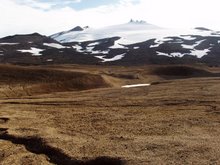The interaction of subglacial volcanoes and their overlying ice cover is characterised by large-scale floods, jökulhlaups, carrying sediment, fresh volcanogenic material and ice.
skip to main |
skip to sidebar

Kate Taylor Smith, Postdoctoral researcher, University of Iceland, kate@raunvis.hi.is
Snæfellsjökull

Welcome
Hello and welcome to my Snæfellsjökull research page. Here you can find information about my Snæfellsjökull floods and hazards project and links to related information. Please feel very welcome to contact me about my research work at kate@raunvis.hi.is For more information about me and my other work please see my main research page.
Snæfellsjökull research information
- Aims (1)
- Background (1)
- Methodology (1)
- Preliminary results and interpretation (1)
- Related publications (1)
Snæfellsjökull links
Thanks
.. go to my mentors at the University of Iceland, Guðrún Larsen and Hreggviður Norðdahl and volunteer field assistants on this project, Claire Robertson, Ross Perrin, Nicholas Cutler, and Ruth Walker.